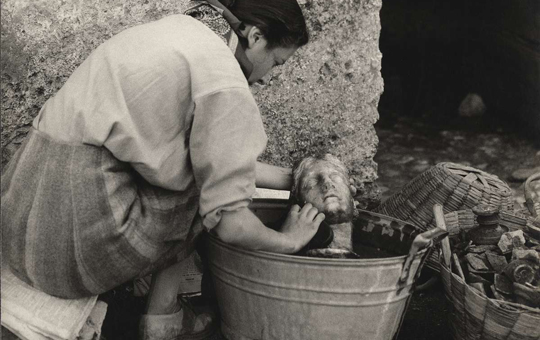The Museum Bulletin
Originally published from 1930–1958, the Museum Bulletin includes articles which may not reflect the current views and values of the Penn Museum.
The editor has now determined ... to issue The University Museum Bulletin, published monthly from November to May, which will include short accounts of the current excavations, descriptions of recent acquisitions to the collections, and the activities of the Museum that are of general interest.

Alaskan Expedition
From 1930 to 1937, Frederica de Laguna conducted pioneering archaeological and ethnographic work in Alaska. She studied Tlingit and Athapaskan peoples, particularly the Eyak, bringing their languages to the attention of the scientific community. Additionally, she was one of the first female archaeologists in the United States, and lead digs in the Prince William Sound.
View Articles
Minturnae Expedition
In 1931, the Penn Museum was able to secure permission from the Italian government to excavate the ancient Roman and pre-Roman city of Minturnae, 50 miles from Naples. Situated along the Appian Way, the site featured a well-preserved aqueduct, several temples, a theater, and baths, as well as important collections of marble sculpture.
View Articles
Warp and Woof
Warp and Woof was a 1949 exhibit of historic and contemporary textiles, with a double aim: to spread before the visitor the almost miraculous products of the primitive loom, and to suggest how infinite are the decorative possibilities to be discovered in ancient and primitive design. Side by side with the rich fabrics of the past were placed newly-created textiles based on objects in the Museum.
View Catalogue
Mask Parade
Mask Parade was a special Halloween exhibit in 1947. The practice of mask-making is nearly universal. Is there a basic motive underlying man’s almost universal preoccupation with false laces? Surely part of the appeal to the observer of a mask collection is conjecture as to this motive.
View Catalogue
The American Collections
The American Halls contain one of the world’s best collections of objects produced by the ancient Maya civilization in Guatemala and adjacent regions, and by some of the other advanced cultures of Middle America. Especially noteworthy are the collection of Maya ceramics, the great Maya stone sculptures from Piedras Negras in Guatemala, the gold and pottery collections from Coclé and Chiriquí in Panama.
View Catalogue
